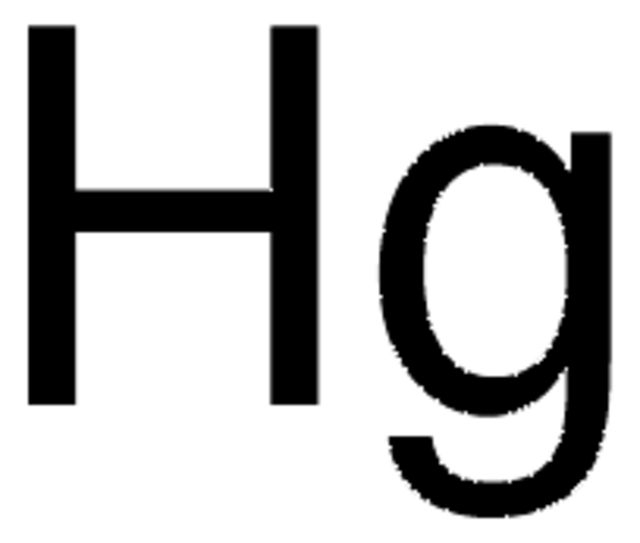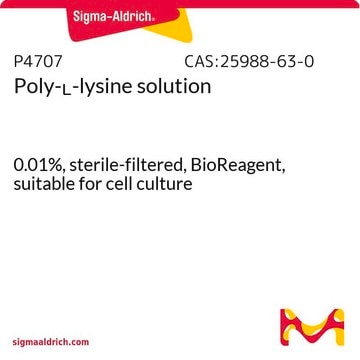If this product has an expiration or retest date, it will be shown on the Certificate of Analysis (COA, CofA). If there is no retest or expiration date listed on the product's COA, we do not have suitable stability data to determine a shelf life. For these products, the only date on the COA will be the release date; a retest, expiration, or use-by-date will not be displayed.
For all products, we recommend handling per defined conditions as printed in our product literature and website product descriptions. We recommend that products should be routinely inspected by customers to ensure they perform as expected.
For products without retest or expiration dates, our standard warranty of 1 year from the date of shipment is applicable.
For more information, please refer to the Product Dating Information document: https://www.sigmaaldrich.com/deepweb/assets/sigmaaldrich/marketing/global/documents/449/386/product-dating-information-mk.pdf
261017
Mercury
≥99.99% trace metals basis
About This Item
Productos recomendados
grado
for analytical purposes
densidad de vapor
7 (vs air)
presión de vapor
<0.01 mmHg ( 20 °C)
1 mmHg ( 126 °C)
Ensayo
≥99.99% trace metals basis
Formulario
liquid
resistividad
95.8 μΩ-cm, 20°C
bp
356.6 °C (lit.)
356.6 °C
mp
−38.87 °C (lit.)
cadena SMILES
[Hg]
InChI
1S/Hg
Clave InChI
QSHDDOUJBYECFT-UHFFFAOYSA-N
¿Está buscando productos similares? Visita Guía de comparación de productos
Descripción general
Palabra de señalización
Danger
Frases de peligro
Consejos de prudencia
Clasificaciones de peligro
Acute Tox. 2 Inhalation - Aquatic Acute 1 - Aquatic Chronic 1 - Repr. 1B - STOT RE 1
Código de clase de almacenamiento
6.1A - Combustible acute toxic Cat. 1 and 2 / very toxic hazardous materials
Clase de riesgo para el agua (WGK)
WGK 3
Punto de inflamabilidad (°F)
Not applicable
Punto de inflamabilidad (°C)
Not applicable
Elija entre una de las versiones más recientes:
¿Ya tiene este producto?
Encuentre la documentación para los productos que ha comprado recientemente en la Biblioteca de documentos.
-
How can I determine the shelf life / expiration / retest date of this product?
1 answer-
Helpful?
-
-
How is shipping temperature determined? And how is it related to the product storage temperature?
1 answer-
Products may be shipped at a different temperature than the recommended long-term storage temperature. If the product quality is sensitive to short-term exposure to conditions other than the recommended long-term storage, it will be shipped on wet or dry-ice. If the product quality is NOT affected by short-term exposure to conditions other than the recommended long-term storage, it will be shipped at ambient temperature. As shipping routes are configured for minimum transit times, shipping at ambient temperature helps control shipping costs for our customers. For more information, please refer to the Storage and Transport Conditions document: https://www.sigmaaldrich.com/deepweb/assets/sigmaaldrich/marketing/global/documents/316/622/storage-transport-conditions-mk.pdf
Helpful?
-
-
I see that Mercury is sold by weight, but it's a liquid. What is the volume?
1 answer-
The specific gravity of liquid mercury at 20°C is 13.546, according to the CRC Handbook of Chemistry and Physics, 82nd ed. (2001-2002), page 4-19. We list several mercury products, in various package sizes, sold by weight. Here are the conversions from mass to volume: 5G = 0.37 mL. 50G = 3.7 mL. 100G = 7.4 mL. 250G = 18.5 mL. 500G = 36.9 mL. 2KG = 147.6 mL.
Helpful?
-
-
What is the Department of Transportation shipping information for this product?
1 answer-
Transportation information can be found in Section 14 of the product's (M)SDS.To access the shipping information for this material, use the link on the product detail page for the product.
Helpful?
-
Active Filters
Nuestro equipo de científicos tiene experiencia en todas las áreas de investigación: Ciencias de la vida, Ciencia de los materiales, Síntesis química, Cromatografía, Analítica y muchas otras.
Póngase en contacto con el Servicio técnico











